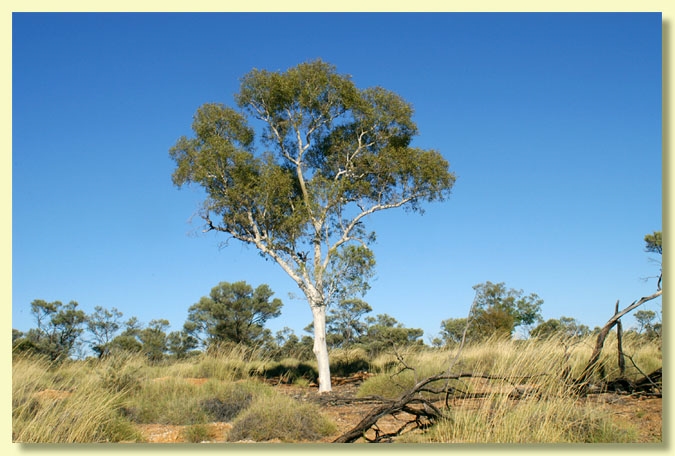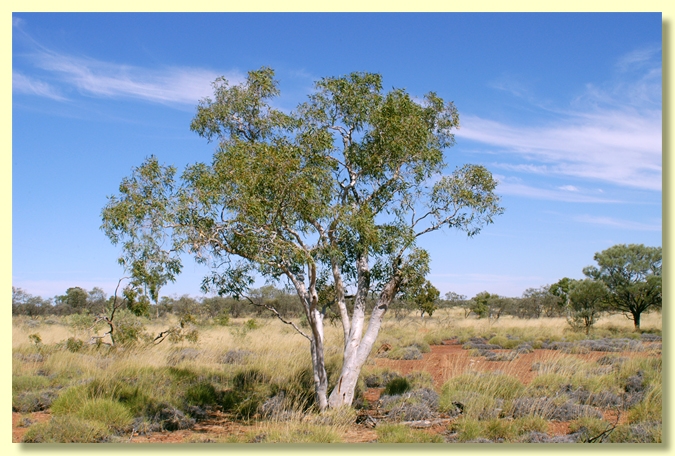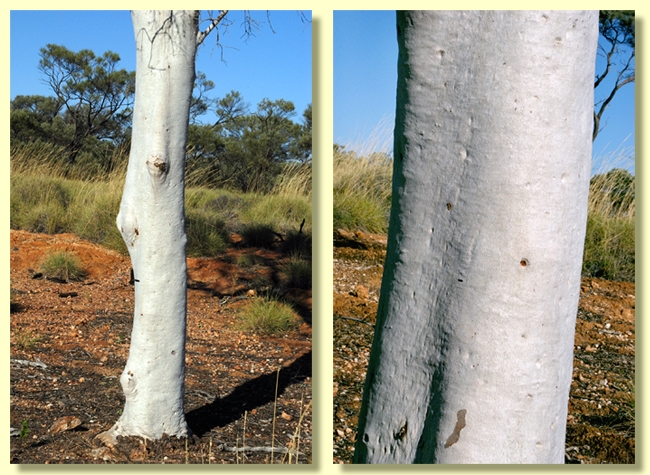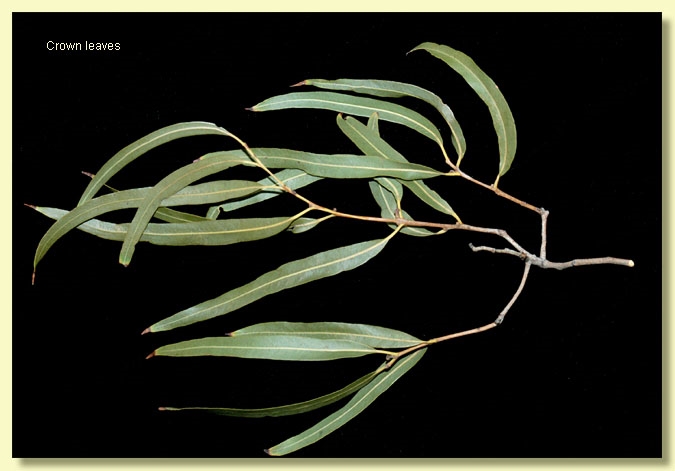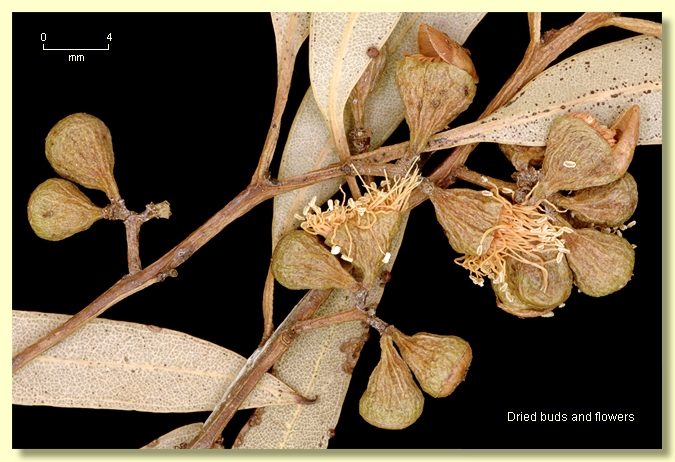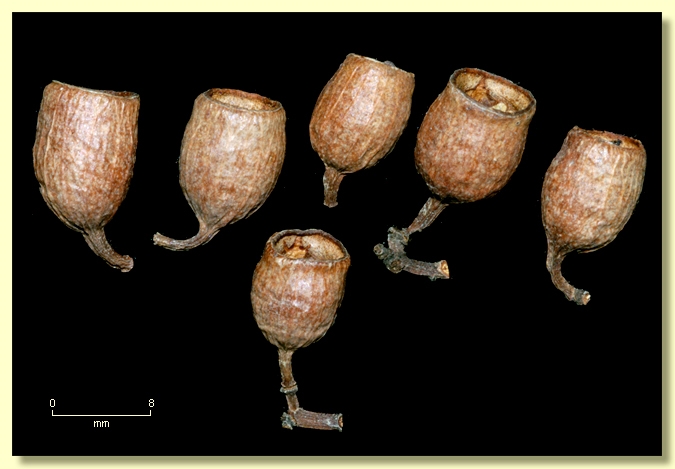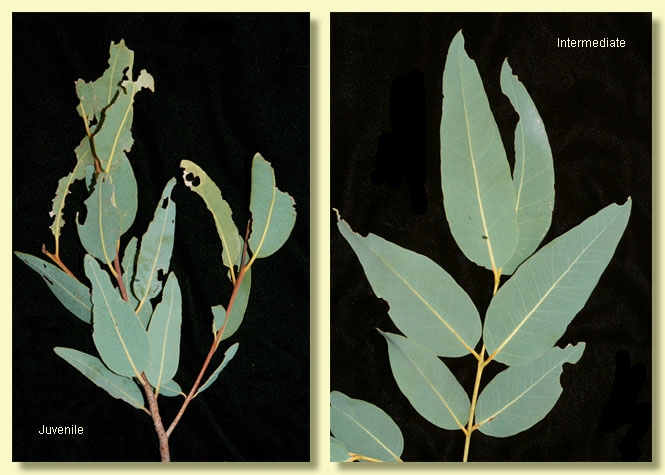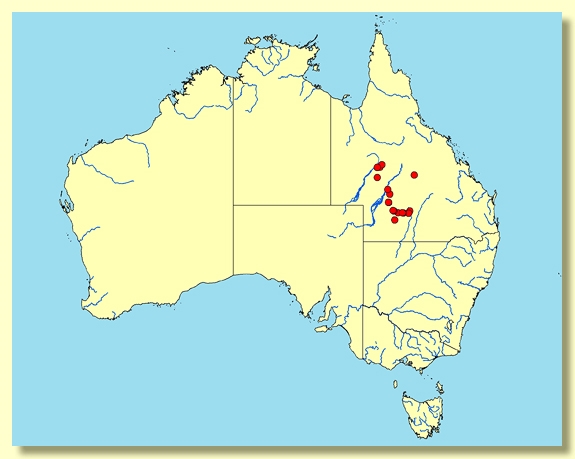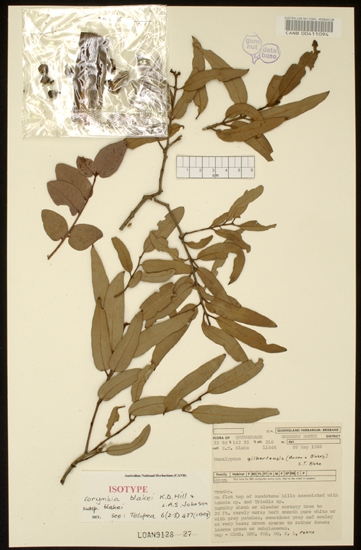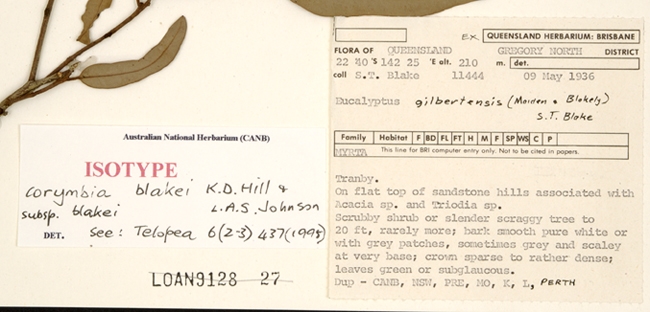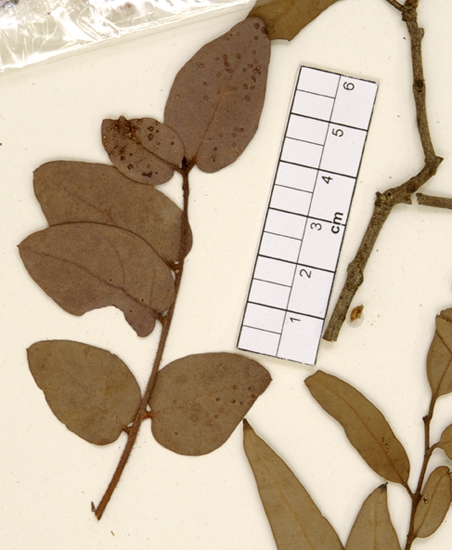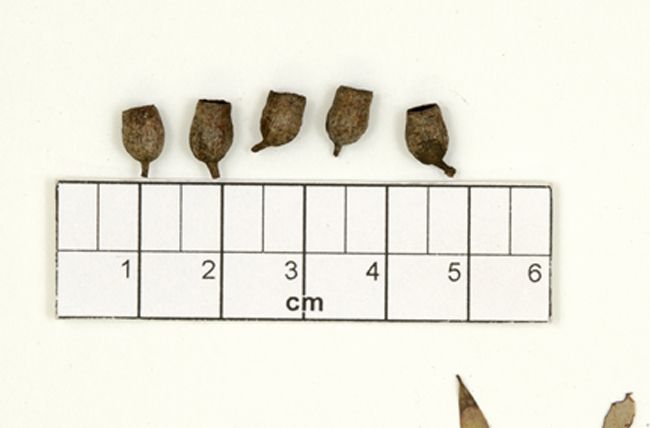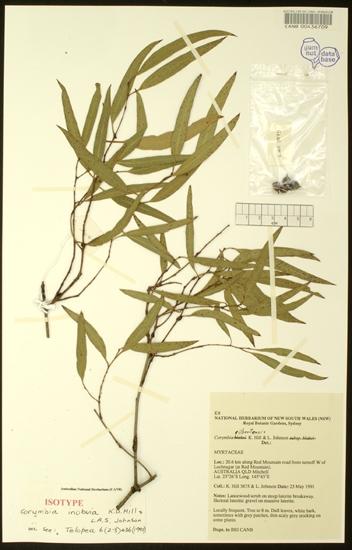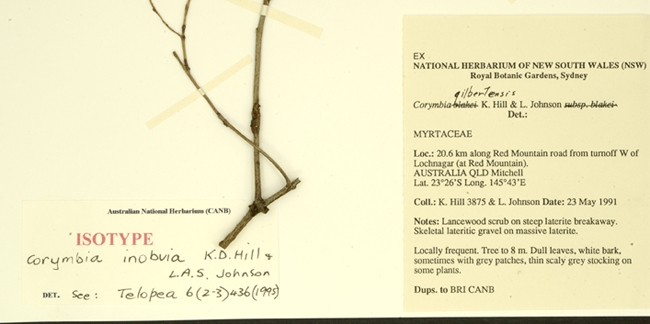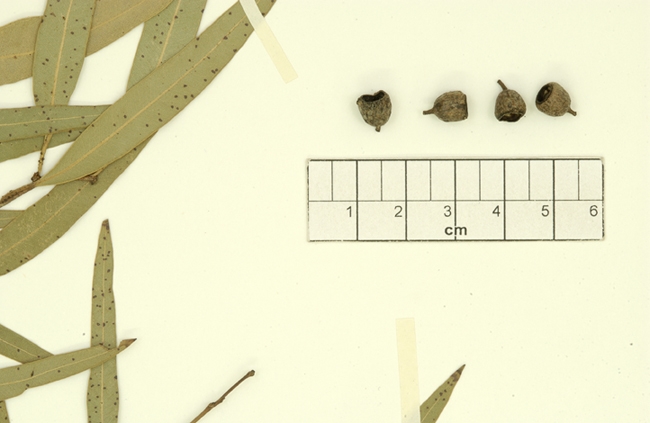Euclid - Online edition
Corymbia blakei
Corymbia | Blakearia
Corymbia blakei K.D.Hill & L.A.S.Johnson, Telopea 6: 437 (1995).
Tree 10 m tall. Forming a lignotuber.
Bark partly rough on oldest plants or wholly smooth on smaller plants; rough bark forming a stocking on lower trunk often very short, rarely for up to 1.5 m of trunk, tessellated and dark grey; smooth bark white to pale cream-grey or pink-grey, powdery.
Branchlets usually have oil ducts in the pith; branchlets not setose or scabrid.
Juvenile growth (coppice or field seedlings to 50 cm): stems rounded in cross-section, setose with bristle-glands bearing simple hairs on lower stem but becoming sparse by 20 cm tall; leaves opposite to sub-opposite becoming alternate on upper stem, shortly petiolate (petioles 0.1–0.2 cm), cordate or ovate to elliptical, 2–6 cm, long, 1–3 cm wide, base lobed to rounded then becoming tapered, margin entire, apex rounded or pointed, green to grey-green, sparsely setose becoming glabrous.
Crown consists of adult leaves.
Adult leaves sub-opposite to alternate, petioles 0.3–1.7 cm long; blade linear to narrowly lanceolate or narrowly falcate, sometimes narrowly elliptical, 4–13 cm long, 0.3–1.8 cm wide, flat, base tapering, margin entire, apex pointed, concolorous, side-veins at greater than 45° to midrib, reticulation dense to very dense, intramarginal vein present, oil glands ?obscure or minute, island.
Inflorescence axillary compound and condensed, the rhachis consisting of a basal internode ca 0.1–0.4 cm long, sometimes a second internode to 0.3 cm long but often absent, bearing peduncles 0–0.2 cm long but of of variable length within a single inflorescence; buds in umbels of (?3)7, pedicels 0.1–0.4 cm long. Mature buds pyriform (0.4–0.5 cm long, 0.3–0.4 cm wide), smooth, scar present (outer operculum shed early), operculum shallowly rounded, stamens inflexed, all fertile, anthers oblong, dorsifixed, versatile, dehiscing by longitudinal slits, style long and straight, stigma blunt, locules 3, the ovules arranged in 3 ± regular vertical rows on the placentae or the rows obscure. Flowers creamy white.
Fruit pedicellate (pedicels 0.1–0.4 cm long), barrel-shaped to ± cylindrical or cupular, 0.6–1 cm long, 0.5–0.9 cm wide, thin-walled, disc descending vertically, valves 3, enclosed.
Seeds not seen.
Cultivated seedlings (measured at ca node 10): not grown yet.
Flowering has been recorded in December.
A species of ghost gum endemic to arid western Queensland, from the Cory Range south-west of Winton south to the upper Paroo and Bulloo River area between Charleville, Quilpie, Adavale and Windorah, with an outlier at Red Mountain north-east of Barcaldine and another near Muttaburra. It grows on harsh sites with little or no soil, the surface often being a hard crust (duricrust, silcrete, ferricrete, lithosol) on low rises, breakaways or mesas, usually in the company of Acacia species. Corymbia blakei is distinguished by its smooth powdery whitish bark with a basal stocking of rough bark on older plants, narrow linear-lanceolate crown leaves that may be glossy or dull green, and has compound but congested inflorescences borne in leaf axils followed by thin-walled fruit.
Within its natural range C. blakei could be confused with the more widespread Central Australian ghost gum, C. aparrerinja. Differences are slight, with C. aparrerinja lacking rough bark, having broader adult leaves and longer and broader juvenile leaves, but with some overlap in dimensions in both cases. C. blakei differs from the more easterly and more widespread ghost gum C. dallachiana, the latter having generally larger adult and much larger juvenile leaves and lacking rough bark altogether. The range of a fourth ghost gum species, Carbeen, C. tessellaris, extends close to that of C. blakei in the Charleville area but should be easily distinguished by the well-developed stocking of tessellated rough bark and the axillary inflorescence with its clearly expanded rhachis with several internodes visible.
In the classification of Brooker (2000) this species, as Eucalyptus blakei, is included in genus Eucalyptus subgenus Blakella (the ghost gums). In their revision of bloodwoods and ghost gums Hill & Johnson (1995) named this species C. blakei, i.e. in genus Corymbia section Blakearia (the ghost gums). Hill & Johnson (ibid.) divided C. blakei into two subspecies, subsp. blakei with ovate juvenile leaves, and subsp. rasilis with narrowly oblong to lanceolate juvenile leaves. We do not regard these two subspecies to be distinctive and have not recognised them in EUCLID. The same authors described C. inobvia, a ghost gum restricted to the Red Mountain area north-east of Barcaldine, citing differences in adult leaf dimension and pedicel length, together with some retained intermediate leaves in the crown and a less congested inflorescence rhachis, as separating it from C. blakei. We have observed that the adult leaf dimensions overlap entirely as do the pedicel lengths, and that C. blakei in the strict sense may also sometimes develop a second internode within the inflorescence. Consequently in EUCLID we include C. inobvia within C. blakei.
MORE ABOUT CORYMBIA
MORE ABOUT GHOST GUMS
Corymbia blakei: in honour of Australian botanist Stanley T. Blake (1911–73).
Stan Blake was a botanist with the CSIRO Northern Australia Regional Survey (1946–1947) and botanist, later senior botanist, at the Queensland Herbarium 1946–1973. He specialised in taxonomy of tropical and subtropical grasses, Cyperaceae, Eucalyptus, Idiospermaceae, Melaleuca and Plectranthus. He published a landmark scientific paper, the first comprehensive account of tropical eucalypts, "Studies on Northern Australian species of Eucalyptus" (Blake 1953).

